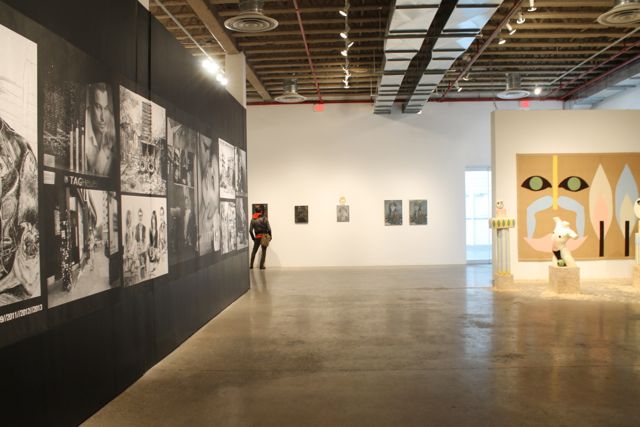ARE YOU ALRIGHT? New Art from Britain
February 1 – March 24, 2013
MUSEUM OF CONTEMPORARY CANADIAN ART
Kitsch and cuteness are fundamental elements of contemporary consumer culture. The combination of the two creates a grotesque vision of the world around us.
ARE YOU ALRIGHT?, a group exhibition of British artists at the MOCCA, curated by Derek Mainella and Elizabeth Eamer, invites viewers to explore the feelings of a new generation of artists living in an era of rising doubt. This exhibition is a meeting of kitsch and filth within the contemporary British landscape that is composed of iconic faces, vivid colour, and household products.
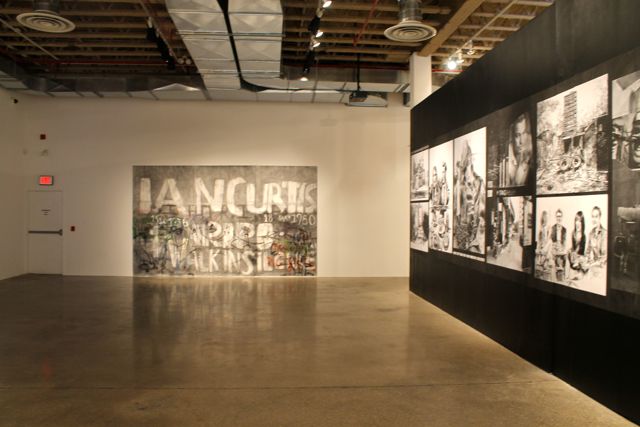 Installation view with Graham Dolphin, Wall (Walk In Silence), 2012 (left) and Laura Oldfield Ford, Drifting through the Ruins (right)
Installation view with Graham Dolphin, Wall (Walk In Silence), 2012 (left) and Laura Oldfield Ford, Drifting through the Ruins (right)
This new generation of artists acknowledges the legacy they have inherited from the Young British Artists (YBA) movement of the 1990’s. A movement of artists that were characterized by their commercial skills and their elitist patronage. This cohort of contemporary artists appears to be in conflict with the values of both society and the art world.
Upon entering the space, the viewer is first impressed with the giant collaged works of Laura Oldfield Ford that resemble the advertisements that plaster our urban streets. Oldfield Ford’s Drifting through the Ruins, photocopied images are mounted on the wall that divides the large gallery space in two. She mixes images of luxury item advertisements with images of subsidized housing, demonstrating the ever widening social gaps that exist within contemporary Britain, and echoed across the rest of the world.
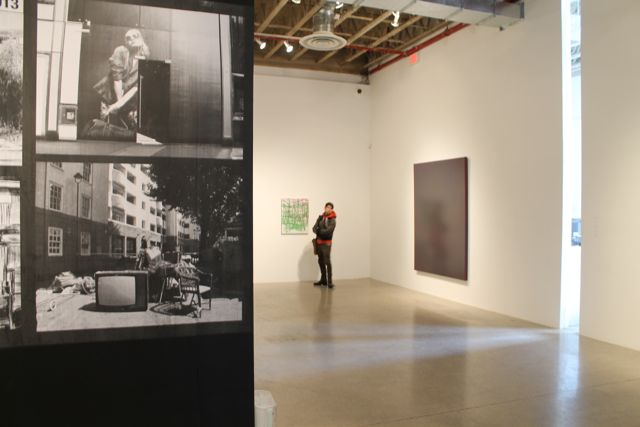 Installation view with Laura Oldfield Ford Drifting through the Ruins (detail, left) and Boo Savillle Boo, To Your Scattered Bodies Go (right)
Installation view with Laura Oldfield Ford Drifting through the Ruins (detail, left) and Boo Savillle Boo, To Your Scattered Bodies Go (right)
The title of the exhibition ARE YOU ALRIGHT?, asks the spectator to question and reflect upon their own stability within a society in flux and does so using the empty construct of kitsch. The mixture of the collective works creates an atmosphere of a shared feeling of absence. The art spans across medium and meaning, the lack of coherence between the styles illustrates a sense of doubt among the exhibition’s participants and is intended to make the viewer feel alienation within the gallery.
Most of the pieces occupy the walls of the large open gallery space. The few exceptions that enter into the viewer’s space was Jonathan Baldock’s Pierrot, mock installation of an imagined museum display of sculptures made out of plush materials and in palette of infant-pastels. This installation demonstrates how even within museums, culture has been degraded to something that can be commoditized.
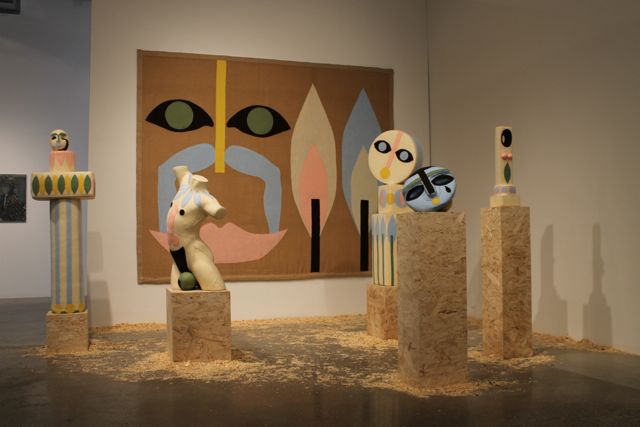 Jonathan Baldock, Pierrot, 2011
Jonathan Baldock, Pierrot, 2011
Harry Burden also explores the commodification of art in his clever appropriation of modern sculptures, recreating these using household cleaners. These three sculptures, which the artist has entitled Sterile Anthromorphic Figure, have been photographed and printed on bleached poster paper, alluding to the bleach bottles the artist used to create his sculptures.
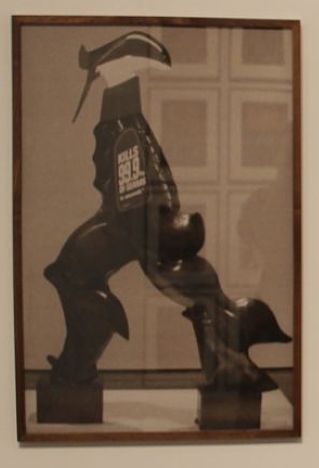 Harry Burden, Sterile Anthromorphic Figure (Boccioni), 2012, digital print on bleached poster paper
Harry Burden, Sterile Anthromorphic Figure (Boccioni), 2012, digital print on bleached poster paper
The white walls of the gallery contrasted with the bright commercial colours, iconic faces and objects, and images imitating urban realties. Graham Dolphin recreates a homage of graffiti in commemoration to the late Ian Curtis, with his mixed media drawing Walk in Silence. Dolphin further explores the relationship between iconography and mass productions. In his video installation, 1500 Images of Kate Moss, the artist demonstrates an iconic image through its mass proliferation can move from the singularity of an idol into a homogenous pattern.
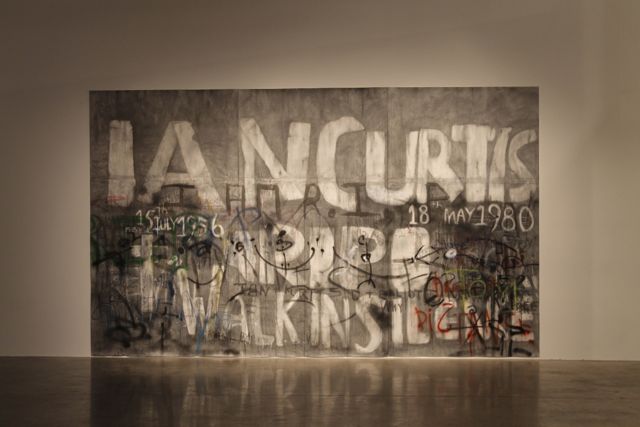 Graham Dolphin, Wall (Walk In Silence), 2012, graphite ink, spray paint, crayon, tippex, marker pen biro on paper
Graham Dolphin, Wall (Walk In Silence), 2012, graphite ink, spray paint, crayon, tippex, marker pen biro on paper
Caroline Achaintre’s ceramic and leather sculptures Panto and Betzy, and the tapestry Swirler are both representations of male and female genitalia. They demonstrate a clear critique of fetishism and vulgarity that has been commodified within society and art.
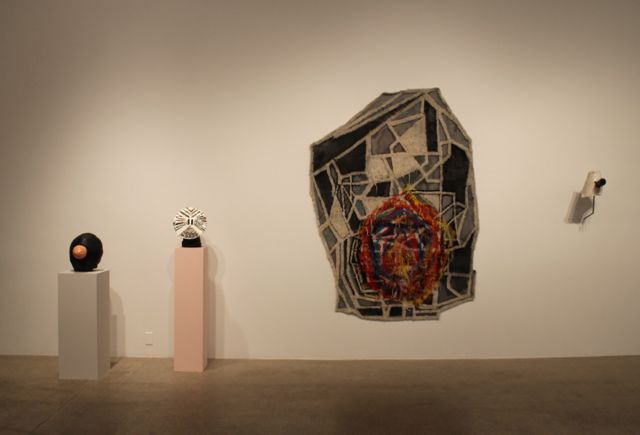 Caroline Achaintre, Panto (far left), leather and ceramic, 2012, and Swirler (middle), 2010, tufted wool, 255 x 164 cm
Caroline Achaintre, Panto (far left), leather and ceramic, 2012, and Swirler (middle), 2010, tufted wool, 255 x 164 cm
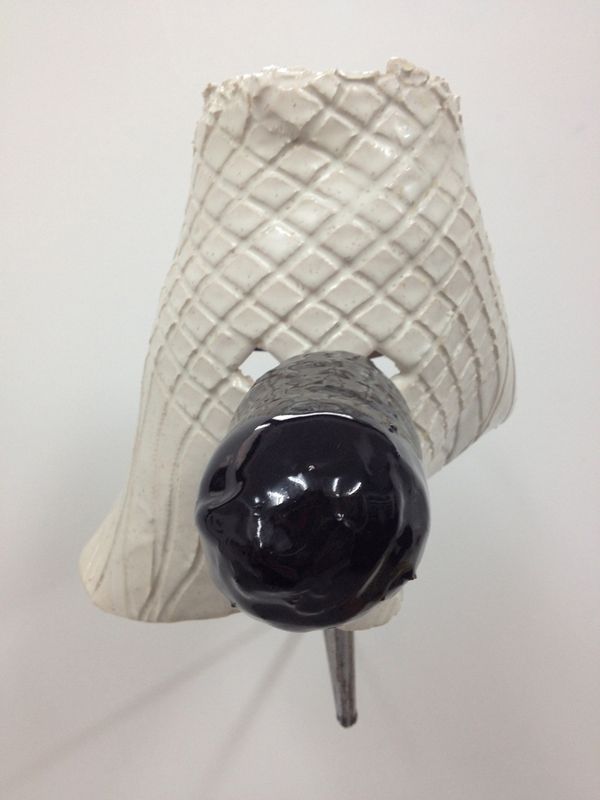 Caroline Achaintre, Betzy, 2012 Ceramic, 23 x 37 x 26 cm
Caroline Achaintre, Betzy, 2012 Ceramic, 23 x 37 x 26 cm
The experience of this exhibition evolves from the bombardment of an abject reality to a retreat into abstraction. This withdrawal is evident in the final piece of Boo Saville. Her canvas, To Your Scattered Bodies Go, harkens back to the Abstraction movements of the twentieth century with their rejection of a world that has lost its moral compass.
Currently the Art Gallery of Ontario has printed works from their own collection on display by the pioneer British Pop artist Richard Hamilton. The work of this new generation of British artist, is a continuation of what Hamilton began when he first pasted together newspaper clippings of the Rolling Stones and Marilyn Monroe. Hamilton’s Swingeing London (1967-1968), with its proliferation of images foretells the ever-increasing infiltration of mass media into our daily lives. Since the rise of the mass media, artists have incorporated and appropriated these images by taking them from the everyday and putting them into galleries as art. By doing so, they ask us to question their value and meaning in our lives. They reveal the effectual truth about these images as they are mindlessly devoured by society.
Text and photo: Alice Tallman

